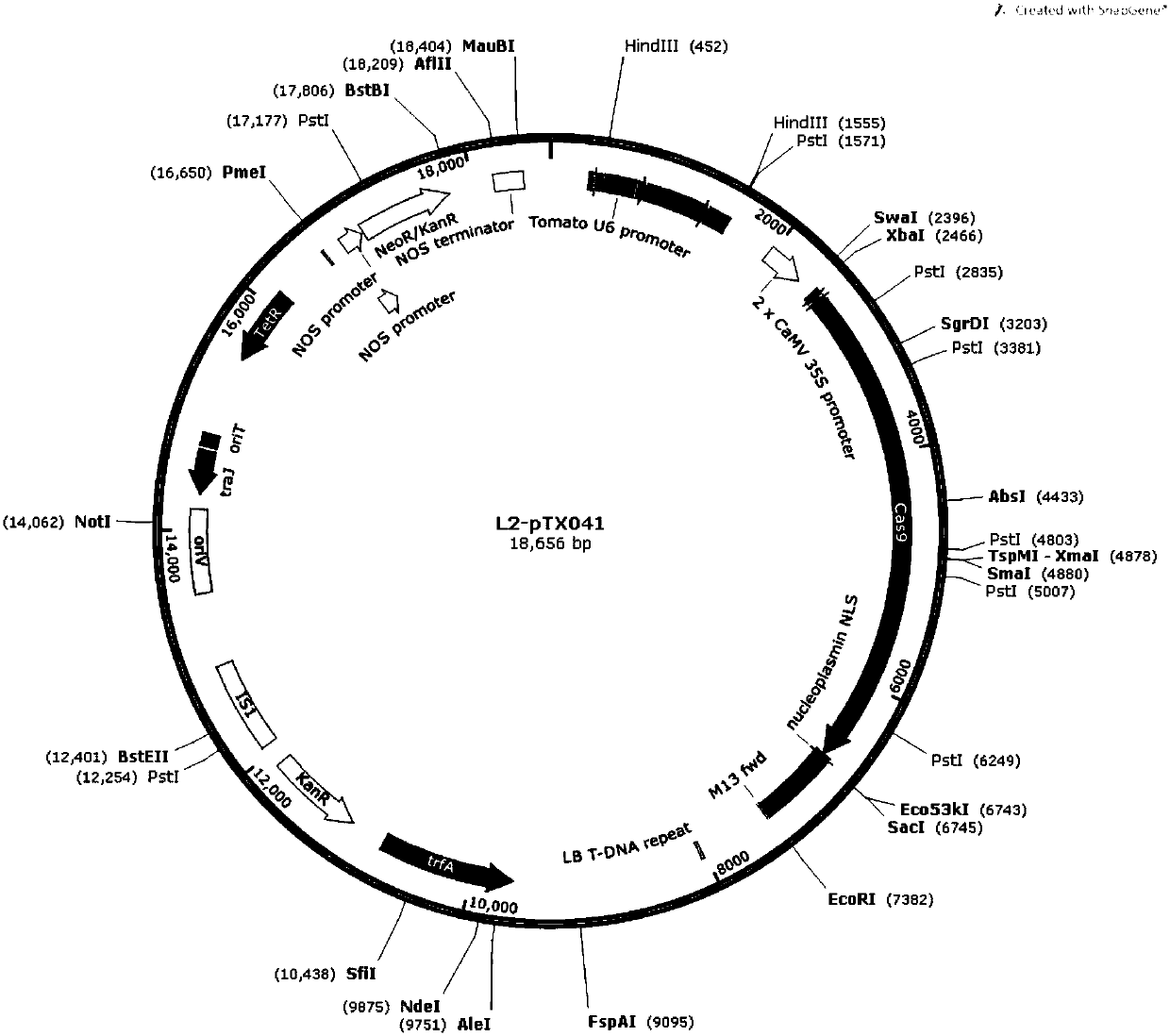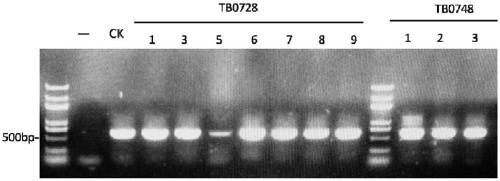Method for creating tomato ginkgo material by gene editing technology
A genome editing and tomato technology, applied in the biological field, can solve the problems of long cycle time and achieve the effect of shortening the transfer time and high editing efficiency
- Summary
- Abstract
- Description
- Claims
- Application Information
AI Technical Summary
Problems solved by technology
Method used
Image
Examples
Embodiment 1
[0062] Example 1, Construction of CRIPSR / Cas9 gene editing vector L2-PTX041
[0063] 1. Obtaining the target sequence of Lutescent2 gene sgRNA
[0064] According to the Lutescent2 (L2 for short) gene sequence registered in the SGN database (http: / / solgenomics.net / ) (the accession number is Solyc10g081470.1.1, and the nucleotide sequence is sequence 1 in the sequence list), the structure of the L2 gene was analyzed . Analysis results such as figure 1 As shown, the L2 gene consists of 10 exons (marked as E1-E10 respectively) and 9 introns. Since the natural mutation occurred in exon 10, the sequence of exon 10 was submitted to the CRISPRdirect online target analysis database (http: / / crispr.dbcls.jp / ) for CRIPSR / Cas9 target design, and the PAM sequence design Set as NGG, species data set as Tomato (Solanum lycopersicum) str.Heinz 1706genome SL2.50. The final selected sgRNA targets such as figure 1 As shown, the L2 gene sgRNA target sequence is as follows: 5'-GAGGAAAGCAGCTCTT...
Embodiment 2
[0074] Embodiment 2. A method of converting tomato powder fruit material into ginkgo fruit material by gene editing
[0075] 1. Transform the gene editing vector L2-PTX041 into Agrobacterium
[0076] Take 1 μg of the gene editing vector L2-PTX041 prepared in Example 1 and place it in 100 μL of LBA4404 competent cells (Beijing Huayueyang Biology, NRR01270), freeze in liquid nitrogen for 3 minutes, bathe in water at 37°C for 5 minutes, and then add 1 mL of YEB medium (YEB medium is made up of solute and solvent, and solvent is water, and the concentration of solute and in medium is: yeast extract 5g / L, peptone 5g / L, beef extract 5g / L, magnesium sulfate heptahydrate 0.5g / L L, sucrose 1g / L), cultured at 28°C for 2-4 hours; centrifuged at 10,000×g for 30 seconds, discarded the supernatant, added 0.1ml YEB medium to resuspend the cells, and spread on a medium containing 50μg / mL kanamycin, 500μg / mL streptomycin and 50μg / mL rifampicin on the YEB plate, cultured in the dark at 28°C for...
Embodiment 3
[0088] Example 3, the acquisition and identification of non-transgenic tomato ginkgo material
[0089] 1. Detection of exogenous DNA fragments
[0090] The TB0748-2 L2 gene homozygous target plant was selfed to obtain the F1 generation seed; the F1 generation seed was sown; after the true leaves grew, the offspring of the TB0748-2 L2 gene homozygous target plant (F1 generation ). Using the genomic DNA of the progeny of the TB0748-2 L2 gene homozygous target plant as a template, and using the nucleotide sequences shown in Sequence 7 and Sequence 8 as primers, the exogenous DNA fragment (cas9) was subjected to PCR amplification and electrophoresis. The progeny without PCR amplification products were selected, that is, the progeny of TB0748-2 L2 gene homozygous target plants that did not carry exogenous DNA fragments.
PUM
 Login to View More
Login to View More Abstract
Description
Claims
Application Information
 Login to View More
Login to View More - R&D
- Intellectual Property
- Life Sciences
- Materials
- Tech Scout
- Unparalleled Data Quality
- Higher Quality Content
- 60% Fewer Hallucinations
Browse by: Latest US Patents, China's latest patents, Technical Efficacy Thesaurus, Application Domain, Technology Topic, Popular Technical Reports.
© 2025 PatSnap. All rights reserved.Legal|Privacy policy|Modern Slavery Act Transparency Statement|Sitemap|About US| Contact US: help@patsnap.com



